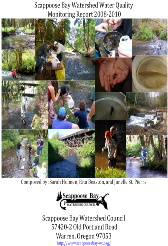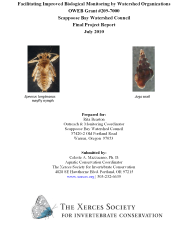The Scappoose Bay Watershed Council frequently conducts water quality and other habitat and biological monitoring efforts. Through grants and partnerships with Oregon Watershed Enhancement Board (OWEB), Lower Columbia Estuary Partnership (LCREP), Oregon Department of Quality (DEQ), Bureau of Land Management (BLM), Oregon Department of Fish and Wildlife (ODFW), Columbia Soil and Water Conservation District (CSWCD), West Multnomah Soil and Water Conservation District (WMSCD), and many landowners, these efforts inform and support an array of other projects.
Water Quality Monitoring
In order to get a full picture of watershed conditions, the council set up 27 monitoring sites throughout the watershed, and sampled monthly between 2008-2010. A Water Quality Report was compiled that includes each site being monitored. The sites were monitored for dissolved oxygen, pH, turbidity, conductivity and temperature, and basic site conditions such as canopy cover, vegetative community composition, and observations of in-stream conditions. Basic macro invertebrate samples were taken at select sites within identified salmonid refugia. Total fecal coliform and E. coli samples were taken at select sites with potential point or non-point source contamination. The Council worked with interns, volunteers, and school groups to collect the site information. Council staff works with the Oregon Department of Environmental Quality to calibrate equipment and conduct quality control of collection techniques. The Council also partnered with the City of Scappoose to process the bacteria samples.
Results of this project identified high temperatures as a major issue in all sub-basins, particularly the lower portions of North and South Scappoose Creeks. Milton Creek had elevated temperatures in both the main stem and in the lower portions of tributaries.
Water quality monitoring was also done at 9 sites in 1998 and 1999, with similar elevated temperature results.
Macro-Invertebrate Monitoring
The Scappoose Bay Watershed Council (SBWC) partnered with the Xerces Society to design and implement a watershed-wide macro invertebrate sampling and education program that collected data used to address stream limitations.
Starting in the fall of 2009, the program developed protocols for sampling, set the sampling sites, and conducted preliminary training for staff and local volunteers and teachers. Participants in the program were able to see the difference in the variety and community composition of macro invertebrates depending on the condition of the stream reach they were sampling. Macro invertebrates are good indicators of stream health. The results of the sampling highlight the effects that human activities such as riparian vegetation removal, bank erosion, and non-point source pollution have on water quality and biodiversity.
Salmon Habitat Assessment
The Scappoose Bay watershed populations of fall Chinook, winter steelhead, and coho salmon have been identified as important sub-populations in the recovery of the Lower Columbia River salmon. The salmon in the watershed hang on a narrow thread of functional population status. A drop in numbers could compromise the genetic integrity of the larger system. Habitat loss and change has been identified as a major contributing factor to salmon decline so it is necessary for us to really understand water quality and habitat concerns in the watershed in order to make effective decisions for protecting our existing populations.


